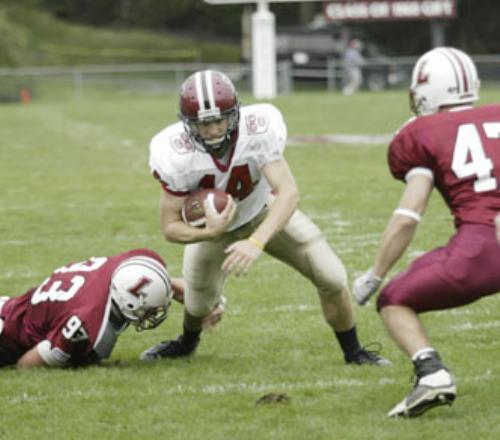
News
Cambridge Residents Slam Council Proposal to Delay Bike Lane Construction

News
‘Gender-Affirming Slay Fest’: Harvard College QSA Hosts Annual Queer Prom

News
‘Not Being Nerds’: Harvard Students Dance to Tinashe at Yardfest

News
Wrongful Death Trial Against CAMHS Employee Over 2015 Student Suicide To Begin Tuesday

News
Cornel West, Harvard Affiliates Call for University to Divest from ‘Israeli Apartheid’ at Rally
MCGINN AND TONIC: Captain's Stats Don't Tell Story

EASTON, Pa.—Through three games this season, Ryan Fitzpatrick has completed 38 of his 64 passes for 560 yards and two touchdowns.
There were single games one year ago in which that might have been his stat line if Harvard coach Tim Murphy had just let him play all four quarters.
Sure, some of that decline is the product of the dismal conditions in the Crimson’s opener against Holy Cross, during which Fitzpatrick completed seven of 15 attempts for 79 yards. But even discounting the act of God that descended on Cambridge that day, his numbers are still down.
And it doesn’t matter. Fitzpatrick is better now than he ever was in 2003.
Does that mean he’ll win the Payton Award this year? Probably not. The totals he puts up by year’s end won’t be as high as those of many of his competitors, and voters who haven’t seen him in person will overlook him as a result.
But will that translate into an Ivy title?
Most likely.
Given the stocked offensive arsenal around him, Fitzpatrick could easily replicate his pre-injury performances. A year ago, Brian Edwards was the only proven and reliable target each week. Now, he and Corey Mazza spread opposing secondaries paper-thin.
It’s not hard to imagine Fitzpatrick throwing to that duo for 400 yards a game. After all, one of them is bound to find single coverage on each down. Given his well-established accuracy, Fitzpatrick shouldn’t have much difficulty finding them.
So far this year, on those limited occasions when the quarterback has taken a chance downfield, he and his receivers have met favorable results—two touchdowns against no interceptions. And, as he has shown in flashes, Fitzpatrick has lost none of his trademark mobility.
Yet the number of deep balls he attempts has gone down. And instead of scrambling for first downs, breaking tackles, and leaving defenders grasping at air, Fitzpatrick regularly dives in anticipation of their approach, accepting shorter gains time and again.
So, given all that, how exactly is he a better quarterback than a year ago?
For one, Fitzpatrick—formerly the invulnerable signal caller who escaped injury time and again by the thinnest of margins—is playing as though he learned from his compulsory time on the sidelines last season.
Spectacular though some of his single-play efforts may have been a year ago, they weren’t worth the broken hand and torn-up knee that arguably arose from the style of play that produced them.
Slipping through a collapsing wall of linebackers may earn a few extra yards. Avoiding that contact altogether may earn a few thousand, and will certainly protect a few extra wins.
And Fitzpatrick appreciates the offensive transformation that occurred in his absence last year. When he went down, he was the best runner on the team. Upon his return, Dawson had assumed that mantle and become the centerpiece of the offense.
Rather than radically realign that system, Fitzpatrick has carefully struck a balance that sacrifices his personal glory for a better shot at the title. With little difficulty, he has realized that this is not the Neil Rose-style offense he inherited a year ago and that’s not a second-option rusher in the backfield with him.
Fitzpatrick knows better than anyone that those sky-high personal numbers are easily within reach, but to attain them would diminish the offensive whole, and that this is no zero-sum game. If he were to throw at the expense of Dawson’s touches, opponents could key on the pass and eventually limit his effectiveness.
At the same time, he witnessed—from the sidelines last year—what happens to Dawson when that threat of an air strike is lifted. Sure, he’ll get his yards, but he’ll fall well short of his potential. And he certainly won’t be scoring three touchdowns a game.
But with the run-pass distribution currently in place, Dawson gets his touches and Fitzpatrick avoids unnecessary exposure. The ball is safe, and so is Fitzpatrick. Holes open in the defensive line, but larger seams provide space in the defensive backfield.
Gone is the carefree run ’n gun quarterback who risked it all on every play last year. In his place stands a much wiser Fitzpatrick, who uses his legs primarily to free up his arm and while on the run finds his receivers as if both were standing still.
The one whose numbers will stay down, only to see his win total rise.
The better one.
—Staff writer Timothy J. McGinn can be reached at mcginn@fas.harvard.edu.
Want to keep up with breaking news? Subscribe to our email newsletter.
